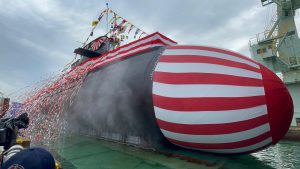Japan’s Mitsubishi Heavy Industries (MHI) has launched the third Taigei-class diesel-electric attack submarine (SSK) on order for the Japan Maritime Self-Defense Force (JMSDF).
The new 3,000-tonne submarine, which has been named Jingei (with pennant number SS 515), entered the water on October 12 in a ceremony held at MHI’s facilities in Kobe City.
JMSDF submarines are currently pressed to expand their roles and missions as China, North Korea, and Russia are all boosting their military muscles around Japan. In particular, Japanese subs could be drawn into a Taiwan contingency, which has become an increasingly real possibility in recent months.
According to the JMSDF, the new submarine has a crew complement of about 70, an overall length of 84 meters, a beam of 9.1 m, a draught of 10.4 m, and a standard displacement of about 3,000 tonnes. It is just slightly larger than the well-known previous Soryu-class SSKs, which have a standard displacement of 2,950 tonnes.
The Taigei class for the first time has female-only compartments such as a living space for up to six women, a spokesman at the JMSDF told The Diplomat on October 11.
The new submarine is expected to enter service in March 2024. Jingei means “speedy whale” in Japanese and was the name borne by an ocean-going imperial yacht and a submarine tender during the Imperial Japanese Navy.
The new submarine, which cost about 70 billion yen ($480 million) to build, is powered by a diesel-electric engine generating 6,000 hp. It has a maximum speed underwater of 20 knots.
The JMSDF said that the new boat is equipped with lithium-ion batteries in place of lead-acid ones, just like the final two Soryu-class boats for the JMSDF: Oryu (SS 511) and Toryu (SS 512).
GS Yuasa, a Kyoto-based developer and manufacturer of battery systems, provided the lithium-ion batteries for those new submarines. So far Japan is the only country known to have fitted lithium-ion batteries into SSKs, with South Korea expected to be the next country to do so with the second batch of KSS-III (also known as Dosan Ahn Chang-ho)-class submarines.
The new Taigei class employs a “compact” and “highly efficient” electricity storage and supply system that extends the submarine’s endurance under water without the need to increase the size of the boats, according to the Japanese Ministry of Defense (MoD).
The class also employs a new combat management system (CMS) combining advanced integrated sensors, command-and-control, and weapon engagement systems, the MoD said.
In addition, it adopts an enhanced snorkel system to reduce signatures, and a new-generation sonar system based on fiber-optic array technology to enhance detection capability.
The Taigei class employs the same torpedo counter-measures system that has been incorporated into the last four Soryu-class boats. It is expected to use Japan’s newest torpedo, which is called the Type 18, succeeding the previous Type 89. Initially referred to as “G-RX6,” the new torpedo will feature improvements in a number of areas, including propulsion, target detection, and processing.
The class is also capable of deploying the UGM-84L Harpoon Block II anti-ship missile against surface targets. This missile range is 248 km – enough for Japan to acquire a “counterattack capability,” which has been still under hot debate in Tokyo.
In May 2015, the U.S. Department of State approved the possible sale of those submarine-launched missiles to Japan. The deal was estimated to be worth $199 million at the time. The Japanese government had requested 48 UGM-84L Block II missiles to supplement the JMSDF’s existing capability of UGM-84C and RGM-84C Harpoon missiles, the U.S. Defense Security Cooperation Agency said.
The lead submarine of the Taigei class, named Taigei (SS 513), was commissioned in March 2022. The second of the class, named Hakugei (SS 514), was launched by Kawasaki Heavy Industries (KHI) in October 2021 and is expected to enter service in March 2023. Taigei mean “big whale” in Japanese while Hakugei means “white whale.”
The MoD has allocated funds for the construction of three more submarines of the class – SS 516, SS 517, and SS 518 – with KHI building the first and third submarine, and MHI the second.
Most recently, on August 31, the ministry requested 80.5 billion yen for fiscal year 2023 starting April to build the seventh SSK, or SS 519, of the class.
A JMSDF spokesperson told The Diplomat on October 12 that Tokyo has not officially decided on how many submarines of this class will be built, but it is likely that at least a total of nine are likely to be built if the current pace of replacement for the aging Oyashio-class submarines continues.

































